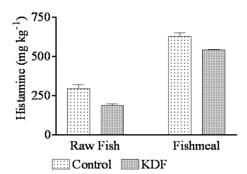Preservation of industrial fish
Improving fishmeal quality through preservation of industrial fish with potassium diformate (KDF)
Published: February 16, 2012
By: Kai-J. Kühlmann, Christian Lückstädt, Somamart Lohmah (Addcon)
Abstract
Raw industrial fish caught in SE-Asia for fishmeal processing decays quickly under tropical climate conditions and leads to lower protein quality. Therefore, it often needs to be supplemented with expensive fishmeal imports by the local feed industry. The effectiveness of potassium diformate (Fishform Plus®, KDF) as a preservative for industrial fish had been tested during a two-week onboard application in the Gulf of Thailand. Results averaged with 146.6 mg 100g-1 total volatile basic nitrogen (TVBN) for the treated fishmeal compared to the control fishmeal (221.7 mg 100g-1TVBN - P<0.05). Likewise, dry matter of fishmeal originating from KDF-treated industrial fish was higher compared to the control fishmeal, leading to increased profitability for all players in local fishmeal operation. Data suggest a 1% application of the KDF-preservative as most suitable under local fishing and climate conditions in order to significantly improve fishmeal quality.
Keywords--- industrial fish, fishmeal, total volatile basic nitrogen (TVBN), potassium diformate.
Introduction
More than a third of the world´s fish harvest is converted into fish meal or fish oil for further application in animal feeds rather than used for human consumption. Of the 95 million tons of fish landings in 2004, about 33 million tons of fish and fish trimmings were processed in this way [1]. As the annual fishmeal production from established producers in South America and Northern Europe declined in recent years [2] special attention is to be given to improving the quality of local fishmeal in the SE Asian region as the center of aquaculture growth and development. However, access to premium quality fishmeal without dehydration damage to proteins is still limited [3].
Since industrial fish quickly decays under tropical climate conditions, its quality drastically declines before reaching the fishmeal factory. This study aimed to develop a technology to drastically reduce biological fish decay and thereby supporting a higher quality fishmeal produced locally in SE Asia.
Methodology
Onboard of a local fishing vessel, industrial raw fish (pony fishes, Leiognathidae) trawled in the Gulf of Thailand within 13 days prior to fishmeal processing was treated with a preservative based on potassium diformate (Fishform Plus®, KDF), before in-hull bunkering and landing at the fishmeal factory. Storage temperatures in the vessels´ bunkers ranged from 9 to 12°C. Upon hauling the trawls onboard, industrial fish was placed into bottom-ice-covered 100 kg drums. About 50% of the total catch (treatment) was sprayed with 1% KDF (based on weight of fish), while the other 50% served as a negative control. Finalized with a top layered ice (total ice ~ 10% per drum), all fish were hull-bunkered and shipped to the fishmeal factory.
Total Volatile Basic Nitrogen (TVBN), dry matter, crude protein, formic acid residues and histamine content were analyzed from the industrial fish and fishmeal of treatment and control group, respectively. Results were t- tested (P<0.05) and a return-of-investment analysis was carried out.
Results
The TVBN of 1% KDF-treated industrial fish was 44% lower compared to control fish resulting in a TVBN content of 169 vs. 298 mg 100g-1 of raw material. Likewise, pooled samples of fishmeal processed from 1% KDF-treated industrial fish resulted in 147 vs. 222 mg 100g-1 (Figure 1) and showed therefore a 34% lower TVBN content compared to control fishmeal.

Figure 1: The KDF-treated raw industrial fish and fishmeal showed a significantly (P<0.05) lower TVBN content compared to control material. (The dotted line benchmarks the highest fishmeal price for TVBN below 150 mg 100g-1in Thailand).
Dry matter (DM) content increased by 4.2% and 3.6% for KDF-treated fish/fishmeal compared to control materials; resulting in 23.5% vs. 22.5% DM for KDF-treated fish and negative control, respectively. DM of fishmeal was 96.1% and 92.6% for treatment and control. Further, KDF-treated fishmeal had a 2% higher crude protein content indicating less nutrient decomposition. Histamine levels were significantly (P<0.05) reduced for industrial fish (188 vs. 295 mg kg-1) and fishmeal (543 vs. 626 mg kg-1) for treatment and control, respectively (Figure 2).

Figure 2: Histamine development in raw fish and fishmeal with or without KDF treatment
Fishmeal production involves several players, such as the fishing boat and a fishmeal processing factory. Often, both parties are independent enterprises striving for maximal profits.
A cost-benefit analysis based on a 1000 kg industrial fish catch revealed that KDF-treated raw fish had a 3.6% higher dry matter content and hence resulted in a higher fishmeal production (+9 kg) than the control. Further, significantly lower TVBN values of 147 mg 100g-1 compared to control (222 mg 100g-1) result in fishmeal belonging to a better "quality class" and earn a higher price compared to low class fishmeal. By deducting the investment of the preservative from the total sales of the high quality fishmeal, a return of investment of 1 to 1.7 was achieved.
Discussion
TVBN is often used as a criterion for the freshness of fish raw material [4]. This value in the fish before processing is known as the most important quality criteria for raw industrial fish and the fishermen is paid according to the measured TVBN level when landing the catch at the fishmeal factories. Its amount increases with time of storage in the unfrozen state; the increase of TVBN in raw fish is quicker under higher temperatures [3]. While in Europe values between 40 to 70 mg 100g-1 of raw fish are desired by the industry [R. Christiansen, pers. communication], TVBN values below 150 mg 100g-1 are of best quality which could be achieved from sardines, pony fishes or anchovies trawled and processed under local SE Asian fishing and climate conditions. Biogenic amines, like histamine, are formed if the bacterial degradation of protein (amino acids) has started and is therefore an important measure for the quality of the fish too. Histamine, for instance, is formed during the bacterial degradation of histidine, which is an essential amino acid in fish nutrition. Contamination with histamine can cause food poisoning and allergic reactions [5]. The significant reduction of histamine levels in fish as well as in fishmeal after treatment with KDF is in agreement with the lower TVBN-levels, since both indices describing lower amounts of degraded fish protein. This was further proven by the higher amount of crude protein found in KDF-preserved fish. As fish biological decay has being reduced by KDF, the dry matter content of treated industrial fish was higher, leading to more fishmeal production and profit compared to the untreated catch landed at the fishmeal factory. Similar results have been obtained with a range of 0.2 to 0.6% KDF applications to sardines and resulted in reduced TVBN levels over a prolonged storage period [6].
Conclusions
Applying a 1% concentration of potassium diformate (Fishform Plus®) to industrial fish directly after the trawl onboard the vessel and bunkering the catch at around 10 °C for up to 10 days will lead to a higher quality industrial fish compared to the control. Thus, fishmeal can be produced with TVBN contents below 150 mg 100g-1 and factories can provide therefore the feed industry with reliable raw materials. Investment returns to fishing boat and fishmeal factory as the former supplies more fish to the fishmeal factory due to a higher dry matter of fish, while the latter processing a high quality fishmeal will obtain higher sales prices to feed mills. In general, this approach could contribute to a more responsible fishing management in local SE Asian waters as well as making the region more import-independent from international fishmeal markets.
Acknowledgements
This study had been made possible through collaboration with all stakeholders involved. Special thanks to the fishmeal factory and fishing boat crews at the Gulf of Thailand.
References
[1] Hassan, M.R., M. Halwart. 2009. Fish as feed inputs for Aquaculture. FAO Fisheries and Aquaculture Technical Paper. 518:426 pp.
[2] Josupeit H. 2009. The Fishsite. http://www.thefishsite.com/articles/690/fishmeal-market-report-may-2009
[3] Lückstädt, C., R. Christiansen. 2008. Potassium diformate in sandeel and sardines. Feed Mix, 16(3): 14-16
[4] Haaland, H., L.R. Njaa 1988. Ammonia and total volatile nitrongen in preserved and unpreserved stored, whole fish. Journal of the Science of Food and Agriculture, 44: 335-342.
[5] Diel, E., N. Bayas, A. Stibbe, S. Müller, A. Bott, D. Schrimpf and F. Diel. 1997. Histamine containing food: Establishment of a German Food Intolerance Databank (NFID). Inflammation Research 46(1): S87-S88.
[6] Lückstädt, C., K.-J. Kühlmann 2011. Fishform Plus: An acid-based preservative for the storage control of industrial fish. Feed Business Worldwide, 3: 38-41.
This paper was presented at the International Fisheries Symposium (IFS) 2011, October 3-5, 2011 at Tanjung Vista Hotel, Kuala Terengganu, Malaysia. Engormix.com thanks for this contribution.
Related topics:
Authors:
ADDCON
Trouw Nutrition
ADDCON
Recommend
Comment
Share
29 de febrero de 2024
GREAT INFORMATION I WOULD ALSO LIKENYO KNOW HOW TO MASK TVBN IN FINISHED PRODUCT FISHMEAL. ANY KIND OF APPLICATION WILL HELP.
Recommend
Reply
8 de diciembre de 2020
Hello sir,
Hope you are doing good
I m into fishmeal business ,please help me how can I reduce tvbn value on dried fish or powdered fish.i would very much appreciate your suggestion.
Thanks
Recommend
Reply

Would you like to discuss another topic? Create a new post to engage with experts in the community.






.jpg&w=3840&q=75)